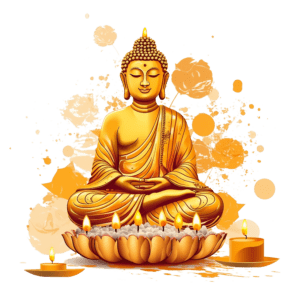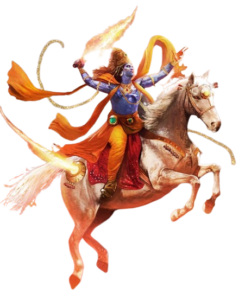Lord Vishnu, one of the principal deities in Hinduism, is known as the preserver and protector of the universe. His primary role is to restore cosmic order (Dharma) whenever it is threatened by chaos (Adharma). To fulfill this divine purpose, Vishnu incarnates in various forms known as avatars. The concept of avatars is central to Vaishnavism, a major tradition within Hinduism. According to scriptures, there are ten principal avatars of Vishnu, collectively known as the Dashavatara. Each avatar has a unique story and significance, symbolizing the triumph of good over evil. Here is a detailed exploration of each of these ten avatars:
-
Matsya (The Fish)
- Story: Matsya is the first avatar of Vishnu, who appears in the form of a fish. According to legend, he saved the sacred Vedas from a demon named Hayagriva who had stolen them. Matsya also warned the sage Manu about the great deluge, helping him save life forms by guiding his ark to safety.
- Significance: Matsya represents the first stage of evolution, from aquatic life. This avatar signifies the importance of preserving knowledge and guiding humanity through crises.
-
Kurma (The Tortoise)
- Story: In this avatar, Vishnu took the form of a tortoise to support Mount Mandara, which was used by the gods (Devas) and demons (Asuras) as a churning rod to extract the nectar of immortality (Amrita) from the ocean of milk (Samudra Manthan).
- Significance: Kurma symbolizes stability and support. This avatar highlights the importance of perseverance and cooperation for achieving great goals.
Download the KUNDALI EXPERT App
-
Varaha (The Boar)
- Story: Varaha, the third avatar, appeared as a boar to rescue the Earth (personified as the goddess Bhudevi) from the demon Hiranyaksha, who had submerged it in the cosmic ocean. Varaha dived into the ocean, fought the demon, and lifted the Earth on his tusks.
- Significance: Varaha represents the emergence of terrestrial life. This avatar emphasizes the protection of the Earth and the victory of righteousness over evil.
-
Narasimha (The Man-Lion)
- Story: Narasimha is a half-man, half-lion avatar who appeared to protect the devotee Prahlada and to defeat his tyrant father, the demon king Hiranyakashipu. Hiranyakashipu had received a boon that he could not be killed by man or beast, inside or outside, day or night, on earth or in the sky, or by any weapon. Narasimha killed him by appearing at twilight, on the threshold of his palace, using his claws.
- Significance: Narasimha symbolizes divine protection and the power of devotion. This avatar demonstrates that divine justice transcends worldly limitations.
-
Vamana (The Dwarf)
- Story: Vamana, the fifth avatar, appeared as a dwarf Brahmin to subdue the demon king Bali, who had gained control over the three worlds. Vamana asked for as much land as he could cover in three steps. When Bali agreed, Vamana grew to an enormous size and covered the earth and heavens in two steps. For the third step, Bali offered his head, accepting his fate with humility.
- Significance: Vamana represents humility and the power of the small and seemingly insignificant. This avatar teaches that pride and arrogance can be subdued by wisdom and humility.
-
Parashurama (The Warrior with an Axe)
- Story: Parashurama, the sixth avatar, was a Brahmin warrior who carried an axe given to him by Shiva. He is known for his violent campaign against the Kshatriyas (warrior class) to rid the world of corrupt and tyrannical rulers. He is said to have cleansed the earth 21 times over.
- Significance: Parashurama symbolizes the necessity of righteousness and the power of justice. This avatar shows that even the priestly class can take up arms to restore Dharma.
-
Rama (The Prince of Ayodhya)

- Story: Rama, the seventh avatar, is the hero of the epic Ramayana. He is the prince of Ayodhya who went into exile for 14 years to honor his father’s promise. During his exile, he fought and defeated the demon king Ravana, who had abducted his wife Sita. Rama’s life exemplifies adherence to Dharma (righteousness) and the ideal qualities of a king, husband, son, and brother.
- Significance: Rama represents the ideal human being and the embodiment of virtue. His story highlights the values of duty, honor, and devotion.
-
Krishna (The Divine Statesman)

- Story: Krishna, the eighth avatar, is the central figure of the Mahabharata and the Bhagavad Gita. Born in the Yadava clan, Krishna played a crucial role in the Kurukshetra War, guiding the Pandavas to victory. He is also celebrated for his divine love, particularly with Radha, and his playful and miraculous deeds during his childhood.
- Significance: Krishna symbolizes divine love, wisdom, and the cosmic play (Lila). His teachings in the Bhagavad Gita offer profound insights into duty, righteousness, and the nature of reality.
-
Buddha (The Enlightened One)

- Story: Siddhartha Gautama, who later became known as Buddha, is considered by some traditions as an avatar of Vishnu. He renounced his princely life to seek enlightenment and attained Nirvana through meditation. Buddha’s teachings formed the foundation of Buddhism, emphasizing the path to liberation through ethical living, mindfulness, and wisdom.
- Significance: Buddha represents compassion and enlightenment. This avatar underscores the importance of inner peace and the quest for spiritual awakening.
-
Kalki (The Future Warrior)

- Story: Kalki is the prophesied tenth and final avatar of Vishnu, who is yet to appear. It is believed that Kalki will descend on a white horse at the end of the current age (Kali Yuga) to destroy the forces of Adharma and restore Dharma, initiating a new era of truth and righteousness (Satya Yuga).
- Significance: Kalki symbolizes the ultimate destruction of evil and the restoration of cosmic order. This avatar represents hope for the future and the cyclical nature of time in Hindu cosmology.
Conclusion
The Dashavatara of Vishnu presents a comprehensive narrative of cosmic cycles, emphasizing the triumph of good over evil and the preservation of Dharma. Each avatar embodies unique qualities and teachings, reflecting various stages of evolution and human experience. These avatars are not only divine interventions but also profound allegories that offer moral and spiritual guidance for humanity. Through these incarnations, Lord Vishnu continues to inspire and guide devotees toward a path of righteousness, wisdom, and compassion.


